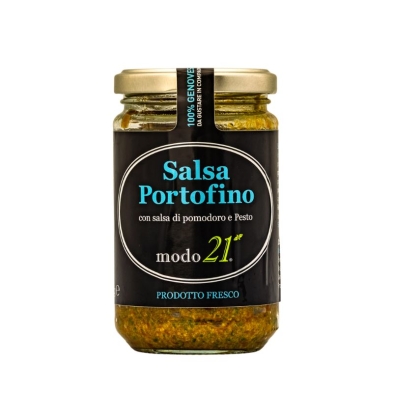Salsa Portofino from modo21 is a sauce based on Genovese pesto (the very good one you eat in Trattoria Cavour modo21) and tomato sauce.
Salsa Portofino is a newly traditional Ligurian sauce, born in the world's most famous seaside village. Despite the risk of excommunication, given the reasonable veneration for pesto that all Ligurians have, this pasta sauce was immediately highly appreciated for its great versatility, mixing the typical flavour of basil pesto with the freshness and natural flavour of tomato.
Portofino pasta is a quick first course, perfect in summer to be accompanied by local wines from the Tigullio Gulf such as Bianchetta genovese or Ciliegiolo, a light and fresh red.
Portofino sauce can be used with almost any format of pasta, from short to long, whether dry or fresh: pasta alla portofino can be made with the more typical trofie pasta but also with penne rigate even if it is no longer tied to tradition. We recommend trying it with Sardinian gnocchetti (dry) or fresh potato gnocchi. Portofino sauce, with its enveloping flavour, is an excellent sauce for dressing large pasta such as pappardelle, picagge, mandilli and lasagne (not baked).
The recipe for picagge matte with Portofino sauce
Picagge are a typical Genoese fresh egg pasta that in shape resembles very wide fettuccine, practically lasagnette. The 'matta' version calls for chestnut flour to be added to the dough in addition to wheat flour.
Ingredients for four serves
- 200 g 0 flour
- 100 g chestnut flour
- 3 eggs
- salt
- 1 jar of Portofino sauce modo21
How to make the pasta
Mix the flours and place them on the pastry board, make a well and create a hole in the centre where you can beat the eggs. Then add the eggs and a pinch of salt. Start working the eggs with a whisk, being careful not to go over the edge of the flour well. Then, always being careful, begin to drop the flour onto the eggs with the help of the whisk, starting from the inner edge of the fountain. When the eggs and flour are sufficiently amalgamated, knead by hand until a smooth dough ball is obtained: in order not to stress the dough too much, alternate phases of work (maximum ten minutes) with moments of rest. When we are satisfied with the dough, we put it to rest for at least half an hour covered with cling film. Once the rest is over, we can roll out the dough to a thickness of 1 mm, cut it into squares or into the shape of wide fettuccine. Leave the picagge to dry on a floured tray. Finally boil in plenty of salted water for a few minutes and season with Portofino sauce diluted with a little cooking water.
![]() By buying this product you can collect up to
1
point
By buying this product you can collect up to
1
point




























